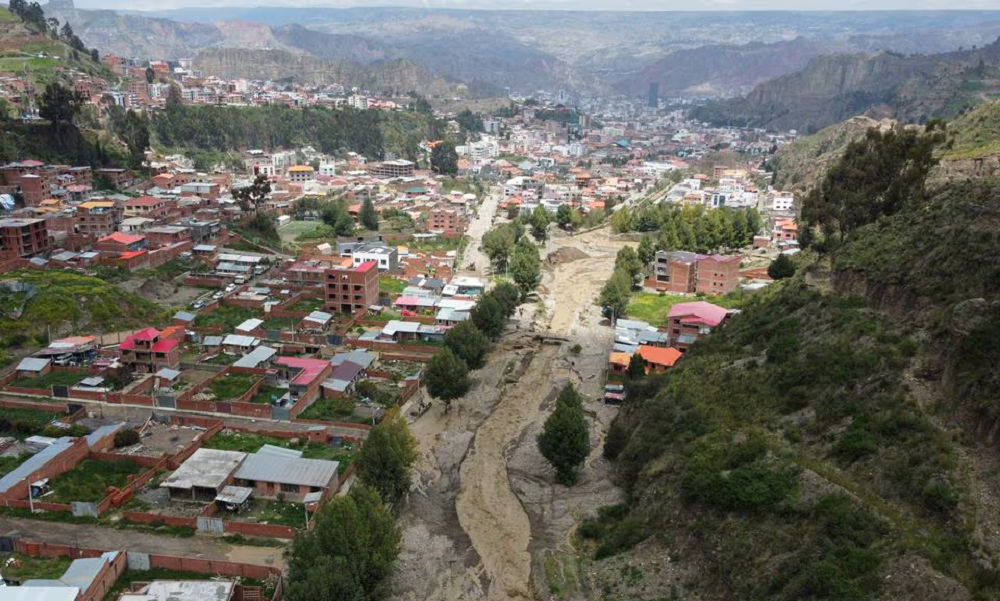Climate Change
‘Nothing’s left’: Hurricane Ian leaves emotional toll behind

With her home gone and all her belongings trashed by Hurricane Ian, Alice Pujols wept as she picked through soggy clothes, toys and overturned furniture piled head-high outside a stranger’s house, looking to salvage something — anything — for her four children and herself.
“I’m trying to make it to the next day,” she said. “That’s all I can do. It’s really depressing. It really is.”
For those who lost everything to a natural disaster and even those spared, the anguish can be crushing to return home to find so much gone. Grief can run the gamut from frequent tears to utter despair. Two men in their 70s even took their own lives after viewing their losses, said the medical examiner in Lee County, where Ian first made landfall in southwestern Florida, AP reported.
The emotional toll in the days, weeks and months after a hurricane, flood or wildfire can be crippling. More pressing needs for food, shelter and clothing often take priority to seeking counseling, which is in short supply even in good times.
“When someone’s in a state of trauma that so many are in, they don’t know where to begin,” said Beth Hatch, CEO of the Collier County, Florida, branch of the National Alliance of Mental Illness. “They need that hand-holding and they need to know that there’s so many people here to help them.”
Hurricane Ian hammered Florida with such ferocity that it wiped out whole neighborhoods, tossed boats onto highways, swept away beaches and swamped homes in roof-deep waters.
With sustained winds of 150 mph (240 kph), it was one of the strongest hurricanes to ever hit southwest Florida. It later cut a watery and wind-battered swath across the Florida peninsula before turning out to sea to regain strength and pummel South Carolina.
It killed more than 100 people, the majority of victims in Florida, making it the third-deadliest storm to hit the U.S. mainland this century. Even a week after it passed through, officials warned that more victims could yet be found as they continued to inspect the damage. The storm knocked out power to 2.6 million and caused billions of dollars in damage.
Research has shown that between a third and half of those who survive a disaster develop some type of mental distress, said Jennifer Horney, an epidemiology professor at the University of Delaware who studies natural disaster impacts on public health.
Post-traumatic stress disorder, depression and anxiety rise along with substance abuse. Those with existing mental disorders are at greater risk of having those conditions exacerbated by the trauma.
A variety of help is available as additional resources are sent to the area.
The state of Florida was setting up support centers and the federal government has a 24-hour disaster distress helpline to provide counseling and crisis support. Hatch’s organization was going to some homes in hard-hit areas to check on clients with mental illness.
The vast majority of people, though, were still assessing damage, trying to retrieve and dry out possessions worth keeping and drag what couldn’t be saved to growing trash heaps by the side of the road.
On Pine Island, just off the Florida mainland where Ian first struck, an emotional Alan Bickford said he was trying to take a longer view because what lay before him was bleak: the floors of his home were coated in stinky muck and his yard was littered with framed photos, furniture and other items he’d hauled outside.
Joe Kuczko hunkered down with his parents as their Pine Island mobile home was battered by the storm. Kuczko got a gash in his foot that he stitched himself after a piece of the roof blew off.
Pieces of mangled metal lay on the ground Thursday along with containers full of possessions and clothes hung to dry as Kuczko, shirtless and with a sunburn on his back, strung up a tarp to keep the rain out of what remained of the home.
“I lost the first 30 years of my life,” he said. “Every time I hear the wind blow and a piece of aluminum shift, it’s like PTSD.”
Climate Change
UN sounds ‘Red Alert’ as world smashes heat records in 2023

Every major global climate record was broken last year and 2024 could be worse, the World Meteorological Organization (WMO) said on Tuesday, with its chief voicing particular concern about ocean heat and shrinking sea ice, Reuters reported.
The U.N. weather agency said in its annual State of the Global Climate report that average temperatures hit the highest level in 174 years of record-keeping by a clear margin, reaching 1.45 degrees Celsius above pre-industrial levels.
Ocean temperatures also reached the warmest in 65 years of data with over 90% of the seas having experienced heatwave conditions during the year, the WMO said, harming food systems.
“The WMO community is sounding the Red Alert to the world,” said WMO Secretary-General Celeste Saulo, who took over the job in January.
“What we witnessed in 2023, especially with the unprecedented ocean warmth, glacier retreat and Antarctic sea ice loss, is cause for particular concern.”
She later told reporters that ocean heat was particularly concerning because it was “almost irreversible”, possibly taking millennia to reverse.
“The trend is really very worrying and that is because of the characteristics of water that keep heat content for longer than the atmosphere,” she said.
Climate change, driven by the burning of fossil fuels, coupled with the emergence of the natural El Nino climate pattern, pushed the world into record territory in 2023, read the report.
WMO’s head of climate monitoring, Omar Baddour, told reporters there was a “high probability” that 2024 would set new heat records, saying that the year after an El Nino was typically warmer still.
Tuesday’s report showed a big plunge in Antarctic sea ice, with the peak level measured at 1 million km2 below the previous record – an area roughly equivalent to the size of Egypt.
That trend, combined with ocean warming which causes water to expand, has contributed to a more than doubling of the rate of sea-level rise over the past decade compared with the 1993-2002 period, it said.
Ocean heat was concentrated in the North Atlantic with temperatures an average 3 degrees Celsius above average in late 2023, the report said. Warmer ocean temperatures affect delicate marine ecosystems and many fish species have fled north from this area seeking cooler temperatures, Reuters reported.
Saulo, a meteorologist from Argentina who has promised to strengthen global warning systems for climate disasters, said she hoped the report would raise awareness of the “vital need to scale up the urgency and ambition of climate action”.
“That’s why we spoke about the Red Alert because we must care for the people and how they will suffer from these more frequent, more extreme events,” she told reporters. “If we do nothing, things will become worse and that will be our responsibility.”
Climate Change
Pakistan, India and Bangladesh bottom in air quality rankings in 2023

Pakistan remained one of the world’s three smoggiest countries in 2023, as Bangladesh and India replaced Chad and Iran, with particulate matter about 15 times the level recommended by the World Health Organization, data published on Tuesday showed.
Average concentrations of PM2.5 – small airborne particles that damage the lungs – reached 79.9 micrograms per cubic meter in Bangladesh in 2023, and 73.7 micrograms in Pakistan. The WHO recommends no more than 5 micrograms.
“Because of the climate conditions and the geography (in South Asia), you get this streak of PM2.5 concentrations that just skyrocket because the pollution has nowhere to go,” said Christi Chester Schroeder, air quality science manager at IQAir, a Swiss air-monitoring organisation.
“On top of that are factors such as agricultural practices, industry and population density,” she added. “Unfortunately, it really does look like it will get worse before it gets better.”
In 2022, Bangladesh was ranked as having the fifth-worst air quality, and India was eighth.
About 20% of premature deaths in Bangladesh are attributed to air pollution, and related healthcare costs amount to 4%-5% of the country’s GDP, said Md Firoz Khan, an air pollution expert at Dhaka’s North South University.
Indian pollution also increased last year, with PM2.5 levels about 11 times higher than the WHO standard. India’s New Delhi was the worst-performing capital city, at 92.7 micrograms.
Only Australia, Estonia, Finland, Grenada, Iceland, Mauritius and New Zealand met WHO standards in 2023.
The IQAir report was based on data from more than 30,000 monitoring stations in 134 countries and regions.
Chad, the world’s most polluted country in 2022, was excluded from the 2023 listings because of data issues. Iran and Sudan were also taken off the 2023 list.
Afghanistan was meanwhile not included on the list.
Climate Change
In Bolivia, heavy rains prompt authorities to declare state of emergency

Heavy rain in Bolivia’s capital, La Paz, prompted authorities to declare a state of emergency, a government document showed on Sunday, after overflowing rivers destroyed many houses over the weekend.
Bolivian President Luis Arce pledged to send heavy machinery and 3,000 troops to prevent further damage, according to the document, Reuters reported.
Heavy rains caused flooding in several neighborhoods and isolated parts of the city by cutting water, electricity and roads.
“We are deeply concerned by the difficult situation that our municipality in La Paz is going through,” Arce said in a post on social media platform X.
One person died over the weekend in La Paz because of the heavy rains, while nearly 50 people have died in deluges across the country since the rainy season began in January, according to official data.
-

 Sport4 days ago
Sport4 days agoACL draw to be broadcast live on ATN channels
-

 Regional4 days ago
Regional4 days agoIRGC chief warns of harsher response if Israel attacks Iran
-

 Regional4 days ago
Regional4 days agoIran launches retaliatory attack on Israel with hundreds of drones, missiles
-

 Sport3 days ago
Sport3 days agoACL fever grows as fixtures finalized
-

 Latest News4 days ago
Latest News4 days agoContact group on Afghanistan hits roadblock over Pakistan’s gripe with India
-

 Sport4 days ago
Sport4 days agoHetmyer powers Rajasthan win in low-scoring IPL thriller
-

 World4 days ago
World4 days agoUN Security Council to meet Sunday on Iran attack
-

 World3 days ago
World3 days agoUS will not take part in any Israeli retaliatory action against Iran

























